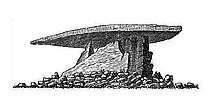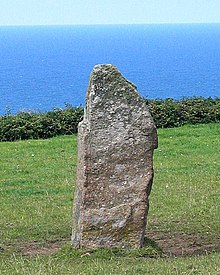Zennor Quoit
The Zennor Quoit is about 5,500 year old portal grave from the Neolithic period and is located near the village of Zennor in the former District Penwith the county Cornwall in England .
location
The Quoit is located 1.5 km east of Zennor. It can be reached on a path that branches off to the left on the road from St Ives about 1 km before the village of Zennor.
There are other quoits on the Penwith peninsula:
construction
Two large portal slabs on the front of the east-facing burial chamber form an entrance and an anteroom at the same time. Behind it is a chamber framed by four stones. The large capstone of the burial chamber weighs over 10 tons and has slipped backwards from the chamber. In front of the tomb, five menhirs form a rectangular structure with sides 3.5 m and 1.5 m long. Modern research today assumes that the structure, as with other quoits, was not completely covered by a pile of earth, but was open to an entrance area.
history
The megalithic complex was first mentioned in 1769 by William Borlase as Senar Quoit . The two adjacent etchings were also made by him . However, there are two essential differences between the pictorial representation and the events encountered today. The stone slope shown around the tomb, for whose diameter Borlase stated 13 m, is no longer available. In the drawing, the cover plate still rests on the chamber, whereby the room height in the chamber was an astonishing 2.4 m according to Borlase. On September 4, 1861, the Cornish Telegraph reported that a local farmer was removing one of the foundation pillars to use the chamber as a cattle shed. According to the prevailing opinion, the cover plate slipped and got into its current position. This is contradicted by the fact that in 1849 W. Willis made an etching on which the cover plate was no longer in its original position. Therefore, the collapse must have occurred before 1849 and was caused by the breaking away of the rear western support pillar, which is still present on the drawing by Borlase. In any case, the village pastor prevented further demolition work by providing the farmer financially so that he did not have to use the stones. A comprehensive description of the Zennor Quoit was provided in 1872 by William Copeland Borlase , a great-grandson of William Borlase, who called the megalithic complex "the most interesting and perfect example of a prehistoric tomb in West Cornwall". He reproduced the etchings shown here and found them particularly valuable, as the monument has been subject to considerable changes since then. Borlase came across the destruction through his grandfather's drawings. The above description of the circumstances comes from him. The more recent representations of the complex by Hencken and Glyn Daniel are short, but Daniel does at least give details of excavation finds on site. Accordingly, there is a prehistoric grindstone found here in the museum of Penzance . Furthermore urns and ceramics could allegedly be recovered.
The Zennormenhir stands nearby.
Individual evidence
- ^ John Barnatt: Prehistoric Cornwall: The Ceremonial Monuments , Turnstone Press Limited 1982
- ^ William Borlase: Antiquities Historical and Monumental of the County of Cornwall , Bowyer and Nichols, London 1769
- ^ William Copeland Borlase: Naenia Cornubiae , Longmans 1872
- ^ Hugh O'Neill Hencken: The Archeology of Cornwall and Scilly , Metheun 1932
- ^ Glyn Edmund Daniel: The Prehistoric Chamber Tombs of England and Wales , Cambridge University Press 1950
literature
- John Barnatt: Prehistoric Cornwall: The Ceremonial Monuments . Turnstone Press Limited 1982, ISBN 0855001291 .
- Ian McNeil Cooke: Standing Stones of the Land's End . Cornwall: Men-an-Tol Studio 1998, ISBN 0951237195 .
Web links
Coordinates: 50 ° 11 ′ 16.6 ″ N , 5 ° 32 ′ 50.7 ″ W.




